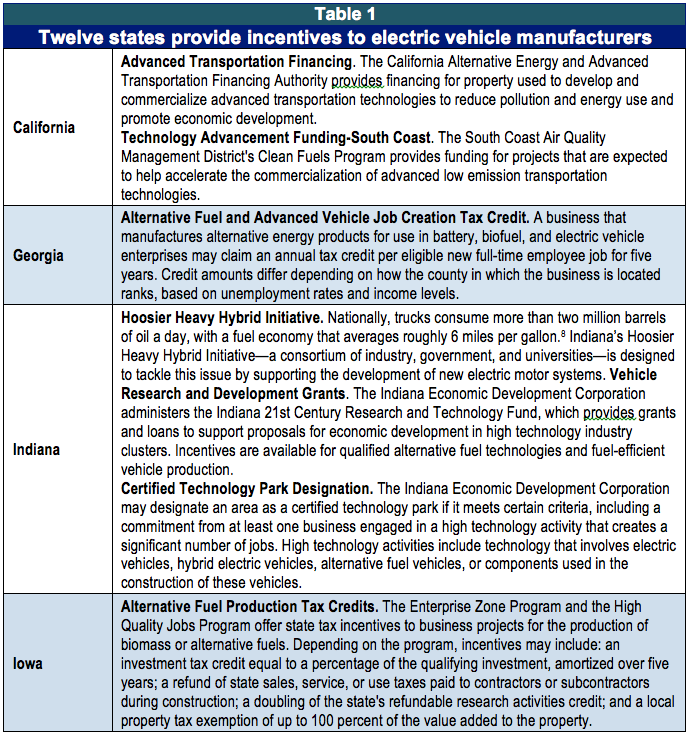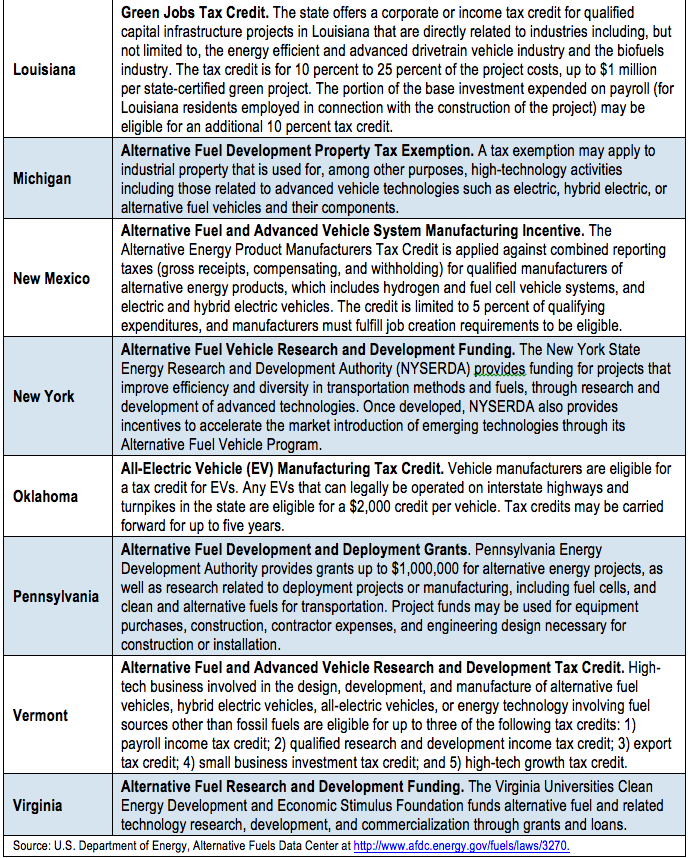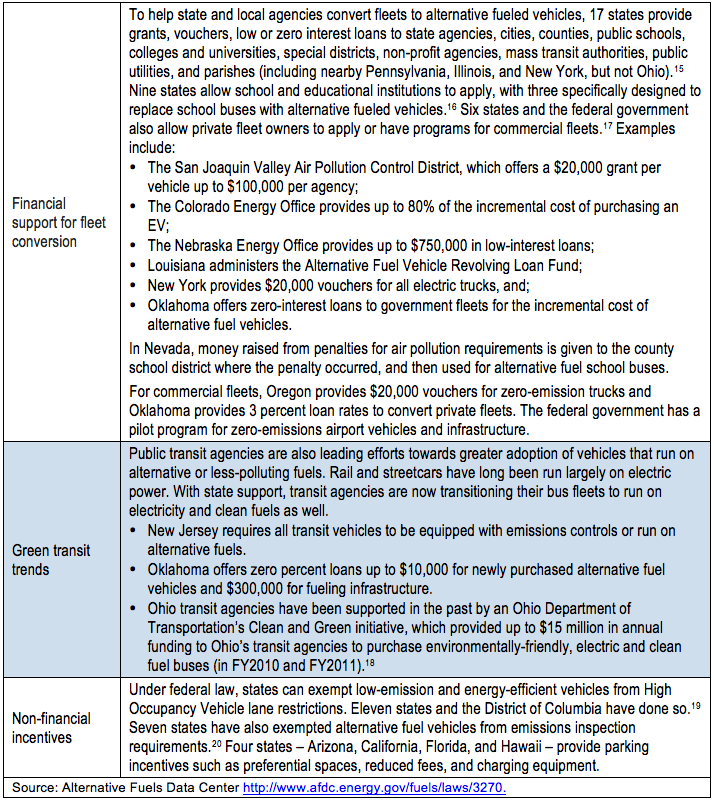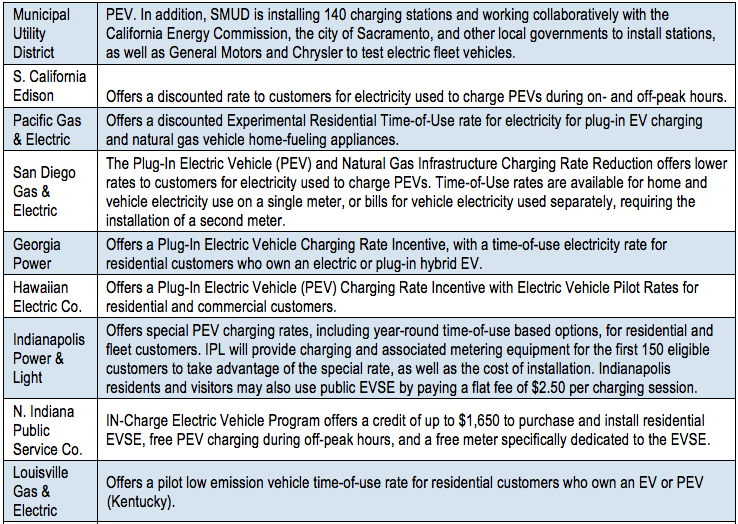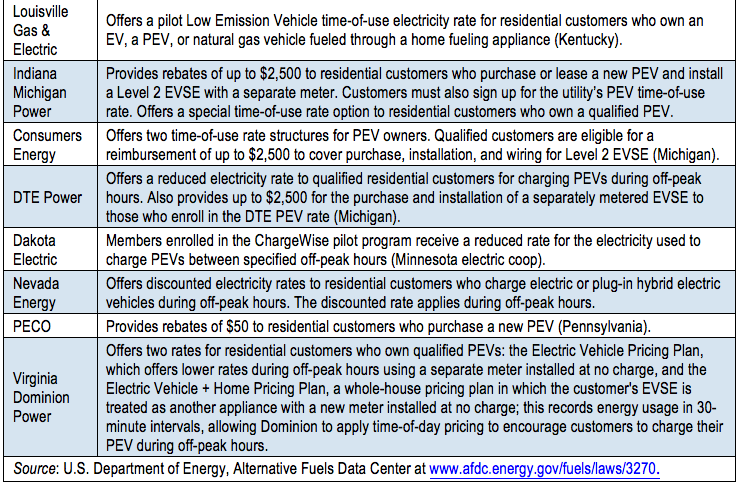
Green Electricity and Transportation (GET) Smart: Policy solutions to increase energy independence
May 08, 2013
Green Electricity and Transportation (GET) Smart: Policy solutions to increase energy independence
May 08, 2013
Download summary (2 pp)Download report (20 pp)Press releaseOhio is well positioned to be a key player in the supply chain for electric vehicles. Other states, however, are working harder to develop the next generation of automobiles by promoting early adoption of the technology.
Executive summary
Ohioans spend a large amount of money on energy. In 2010, we spent $45 billion, nearly 10 percent of our state’s gross domestic product.[1] Nearly half of those energy dollars (or more than $20 billion) was spent to fuel cars, trucks, and buses, and nearly all of which left the state or country in order to import oil. Ohio can reduce its dependence on imported oil by 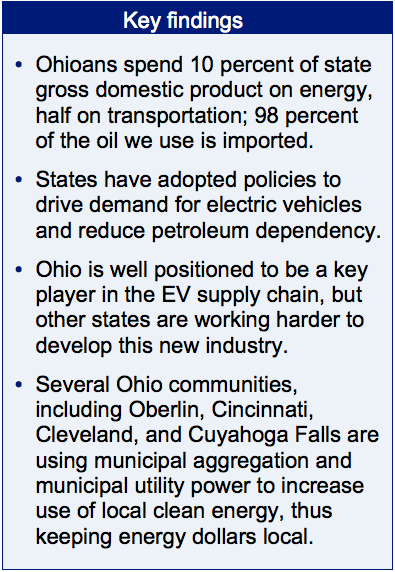 promoting electric vehicles (EVs) and buses, as well as passenger and freight rail.
promoting electric vehicles (EVs) and buses, as well as passenger and freight rail.
Positive policy changes, market trend are driving demand for electric vehicles.
Federal Corporate Average Fuel Economy (CAFE) standards will drive production and adoption of EVs. California adopted similar technology-driven standards, which will lure manufacturers of EV technology to the state.
If consumers demand EV technology, somebody will need to manufacture it. Ohio is well positioned to be a key player in the EV supply chain if the state promotes early adoption of this technology. Other states, however, are working harder to develop this new industry. In 2012, Californians bought one-third of all electric vehicles, in large part because of strong local incentives. Ohio currently has none.
Federal and state incentives, as well as state fleet requirements help drive demand. Of course, incentives should only be implemented with strong standards and accountability. The federal income tax credit for plug-in electric vehicles (PEVs) ranges from $2,500 to $7,500. A number of other states offer additional incentives. Pennsylvania, for instance, offers residents $3,500 in rebates for EVs. The majority of states favor alternative fuel vehicles over conventional fuel vehicles in their procurement process. In the past, the Ohio Department of Transportation has supported green transit vehicle adoption with the use of flexible federal funds allocated to the state.
Investments in electric vehicle infrastructure reduce barriers by ensuring greater availability and convenience of charging stations. Electric-car maker Tesla plans to build a nationwide network of solar “supercharger” stations. Ford has been working on a joint project with the solar manufacturer SunPower to provide solar panels to EV owners for home charging. The Drive Electric Ohio initiative has been working to map existing infrastructure and identify key locations for future infrastructure development.
Policy changes, market trends translate into homegrown electricity from cleaner energy resources to fuel our cars and trucks in the future.
Ohio’s clean energy laws require that 25 percent of electric generation come from advanced energy resources by 2025; half must be generated in state. Ohio utility companies also must achieve a 22 percent reduction in overall energy use by 2025.
Low natural gas prices, due in part to shale gas production in the state, will affect Ohio’s electricity mix, increasing use of homegrown energy and thereby reducing emissions. Natural gas burns cleaner than coal, and natural gas power plants are also more efficient. If 30 percent of Ohio power was generated from natural gas and 12.5 percent from renewable energy sources, we estimate that emissions from Ohio’s electric power sector would be 33 percent lower.
Smart local policies are increasing use of renewable energy from local resources. Exciting examples include aggregated green power purchase in Cincinnati, the community-wide green development effort in Oberlin, Sustainable Cleveland 2019, and the city of Cuyahoga Falls’ Community Energy Strategic Plan. In these cities, PEVs will be running on up to 100 percent clean power, much of it from domestic resources.
Green Electricity and Transportation (GET) Smart policy solutions can help cities build on these positive trends toward energy independence.
Cities can adopt complete street policies to be accessible to all modes of transportation, including walking, biking, mass transit, and EVs.
Public power, local government, and planning officials should participate in Drive Electric Ohio, a statewide stakeholder network organized by Clean Fuels Ohio, made up of public and private stakeholders, designed to identify and address major barriers to travel via EVs. One excellent resource for this collaborative could be the new statewide network of Ohio’s metropolitan planning organizations. Among other issues, MPOs should help finance EV infrastructure projects.
More communities should take advantage of their potential for energy self-reliance. They can do so by using their municipal aggregation or utility powers to procure homegrown energy from clean sources, which Cincinnati and Oberlin have done, and Cleveland is now doing.
The State of Ohio can support local GET Smart efforts and the development of the state’s electric-vehicle supply chain.
There are several opportunities that will help Ohio reach these goals:
- Create a Transportation Choice fund in Ohio's transportation budget. By 2030, ramp funding up to 10 percent of the state’s multi-billion dollar transportation budget;
- Expand Ohio’s Advanced Energy Fund and using it to provide grants, rebates, vouchers, and low-interest loans to promote EV adoption;
- Protect and expand Ohio’s clean energy laws;
- Identify existing Ohio manufacturers that can participate in the EV supply chain, helping them retool to meet the needs of this industry, and investing in related research and development.
Fueling Ohio’s cars and trucks
 We spend a lot on energy, much of it to fuel cars and trucks. Ohio ranks sixth among states in terms of the amount its residents and businesses spend on energy. In 2010, Ohioans spent $45 billion, nearly 10 percent of our state’s gross domestic product. About half of those energy dollars – more than $20 billion – was spent to fuel cars, trucks, and buses. Figure 1 shows that transportation accounted for 45 percent of Ohio’s energy expenditures that year.
We spend a lot on energy, much of it to fuel cars and trucks. Ohio ranks sixth among states in terms of the amount its residents and businesses spend on energy. In 2010, Ohioans spent $45 billion, nearly 10 percent of our state’s gross domestic product. About half of those energy dollars – more than $20 billion – was spent to fuel cars, trucks, and buses. Figure 1 shows that transportation accounted for 45 percent of Ohio’s energy expenditures that year.
Ohio imports the vast majority of fuel used
Nearly three quarters of Ohio’s $45 billion in energy expenditures leave the state. Ohio currently produces 27 percent of the total energy it consumes—only 2 percent of petroleum we use, 10 percent of natural gas, and 48 percent of coal. On the other hand, 93 percent of the renewable energy we use is produced in state. Figure 2 compares energy production to consumption among these various energy resources.
Electric vehicles will reduce reliance on foreign oil
The federal Corporate Average Fuel Economy (CAFE) standards are driving the necessary innovation in advanced vehicle technology, as well as the production and adoption of EVs. By model year 2025, the CAFE standards are expected to nearly double vehicle efficiency, increasing fuel economy for cars and light-duty trucks to the equivalent of 54.5 miles per gallon, while saving consumers an estimated $1.7 trillion at the gas pump.[2] By 2035, hybrid and plug-in hybrid vehicles are projected to grow nationally to about 1.3 million vehicles. [3] By 2040, half of all new light-duty vehicles are projected to use diesel, alternative fuels, or hybrid technology. Heavy-duty alternative-fueled vehicles are expected to increase as well. Additionally, California’s emission and production standards require manufacturers (with annual state sales greater than 60,000 vehicles) to produce and deliver a certain percentage of zero-emission vehicles and to meet the state’s average fleet emission requirements. Since California is a high-demand state for vehicles, these standards will have a national impact on electric vehicle production.
Vehicle efficiency saves money, creates good jobs
The Blue Green Alliance estimates the federal CAFE standards will create more than 500,000 full-time U.S. jobs by 2030 due to money saved and thus kept in the nation’s economy, with 50,000 of them in vehicle manufacturing.[4] Ohio should be a key player in the electric vehicle manufacturing supply chain, but if the demand is elsewhere, so might the supply. As mentioned earlier, the new federal fuel standards are expected to create tens of thousands of jobs manufacturing advanced energy vehicles. Ohio is well positioned to capture many of those jobs. Almost 600 Ohio companies already operate in the automotive industry, employing almost 80,000 people, and producing more than one million vehicles a year. We rank third in the nation for motor vehicle production, second for Tier-1 suppliers, and fourth for automotive assembly.[5]
According to the Blue Green Alliance, nearly 14,000 Ohioans are already helping to produce fuel efficiency technologies.[6] A study by Duke University’s Center on Globalization Governance and Competitiveness found that at least 35 Ohio companies and organizations would benefit from increased investments in hybrid technology for medium and heavy-duty trucks alone. Surprisingly, most relate to work derived from greater investments in public buses and passenger rail through component part production. Several relate to clean passenger vehicle technology: Eaton in Cleveland and ISE in Maumee provide power electrification systems for vehicles; Cobasys in Springboro provides electric motors, and; Bosch Rexroth in Wooster for engineering hydraulic hybrids. Ohio original equipment manufacturers are also expected to benefit, including: Ford Motor Company in Avon Lake; Kenworth Truck Company Chilicothe; Oshkosh Truck Corporation in Orrville, and; Navistar International Corporation in Springfield. Ohio University, Ohio State University, and University of Toledo conduct related research and development.
With help from American Recovery and Reinvestment federal stimulus dollars, a leading global chemical company, BASF, recently expanded and retooled its Elyria plant to manufacture materials used in advanced lithium ion batteries for hybrid/electric vehicles. As a result, it is expected to employ an additional 25 people.[7] Even more recently, Ford announced plans to invest $200 million in a Cleveland plant and create 450 new jobs manufacturing the award-winning EcoBoost engine®.
Other states, however, are working harder to develop this new industry. By promoting demand for EV-related products, encouraging early adopters, developing the needed infrastructure for rapid EV adoption, and offering consumer and manufacturing incentives, a number of states are making their states EV-business friendly. By doing so, these states could firmly establish themselves as the new epicenters of an advanced vehicle technology supply chain, and leave Ohio behind. These states are setting standards, providing incentives, establishing strong procurement requirements and funding mechanisms to support fleet transition, establishing public/private partnerships, and developing the necessary infrastructure to promote electric vehicle adoption and thus increase local demand. Table 1 shows that 12 states are providing incentives to manufacturers of electric vehicle technologies. Ohio is not one of them.
Federal, state, and local incentives help jumpstart the market
To help jumpstart the electric vehicle market, reduce consumer dependency on petroleum and save money over the life of a vehicle, the federal government and many states are offering incentives to early adopters of EV technology and other alternative fueled vehicles.[8] Table 2 describes those incentives in further detail. Unfortunately, Ohio currently has no such incentives.
Federal Congestion Mitigation and Air Quality (CMAQ) dollars support state incentives
The federal CMAQ program provides funding to state departments of transportation, municipal planning organizations, and transit agencies for projects/programs in air quality nonattainment areas to reduce transportation-related emissions. Eligible activities include transit improvements, development of alternative fueling infrastructure, and conversion of public fleet vehicles to operate on cleaner fuels. Ohio uses $10 million per year in CMAQ funds for its Diesel Emissions Reduction Grant program, which, among other things, is used to provide grants for the replacement of old vehicles with new ones (such as hybrid and alternatively fueled vehicles, and permanently removing the old vehicle from service).
Alternative fuel vehicle and transportation-efficiency funds in the states
A few states have created funds to promote adoption of alternative vehicles. Illinois requires non-EV fleet owners (with fleets of 10 or more vehicles) to pay an annual user fee of $20 per vehicle, which is then deposited into an Alternate Fuels Fund. California’s fund derives revenues from a motor vehicle registration fee program, North Carolina from an EPAct Credit Banking and Selling program, and Nevada from penalties assessed for violations of air pollution control laws.
Federal and state fleet requirements and incentives[9]
The federal government, 35 states, and the District of Columbia have green fleet policies to increase the efficiency of public and private fleets, decrease emissions, and reduce dependence on oil.
Development of electric vehicle infrastructure
One major barrier to wide-scale adoption of EVs is the limited availability of charging stations to charge vehicles at home, work, stores, and rest areas. To address this, Ford Motor Co. and SunPower, are partnering to enable EV owners to help meet home-charging needs with solar power. EV carmaker Tesla plans a nationwide network of solar electric “supercharger” stations for all of their vehicles. This will begin with charging stations in California and expand to high-traffic corridors across the country, eventually enabling Tesla electric car owners to drive anywhere powered by sunlight. To enable other EV owners to travel this freely, state and local governments are studying infrastructure needs, coordinating with public, private, and utility partners, disseminating information to consumers, and providing funding and financial incentives to encourage infrastructure investments.
Electric utility actions and incentives
Electric utility companies are seemingly natural partners in the EV market, but many investor-owned electric utilities have taken a ‘wait-and-see’ approach rather than proactively supporting its development. Ohio’s investor-owned utilities are studying potential EV market penetration and expected grid impact. FirstEnergy and AEP are also working with EV stakeholder groups to support PEV readiness initiatives and setting up small demonstration projects, but nothing bold. This is the case in most states. As a result, seven states have directed their public utility commissions to study potential effects of EVs on the grid, evaluate policies to overcome barriers, and adopt rules and incentives to promote their widespread use (including California, Florida, Maine, Maryland, Delaware, Oregon, and Virginia). Interestingly, Duke Energy provides incentives in Indiana and the Carolinas, but not Ohio (up to $1000 to help cover costs of charging stations and free maintenance). Table 5 shows that despite investor-owned utility reluctance, a number of municipal- and consumer-owned utilities have taken a lead on helping to build up the infrastructure for EVs.
Using homegrown power from clean energy sources to fuel our cars
Pure electric vehicles, those without petroleum reserves, have no tail pipes or tail pipe emissions. But they do plug into the electric grid, which is currently outdated and inefficient, and loses more energy during generation and transmission than actually reaches the end user. This inefficiency in the electric power sector is a source of unnecessary emissions, a waste of money and a drain on Ohio’s economy. It also reduces the immediate net positive environmental impact from the transition to electric vehicles from conventional fuel vehicles. However, when the transition to electric vehicles is put in the context of long-term trends in the electric power sector to become more efficient and to generate energy from clean, local resources, the economic value from transition becomes clear. Positive trends in the electric power sector mean that homegrown power from clean energy sources will increasingly be used to fuel our cars, reducing our reliance on imported oil, keeping energy dollars local, and reducing emissions. Figure 3 shows that the electric power and transportation sectors, combined, currently account for three-quarters of Ohio’s carbon emissions.
Inefficiencies in the electric power sector are due to our centralized system of generating electricity, which relies largely on coal and wastes an enormous amount of heat energy. Heat produced from burning coal could be put to better use by piping it into homes for heating, or to industry for use in the manufacturing process (to bend metals, for instance). However, coal power plants are primarily located in remote regions of the state, away from manufacturing and urban centers where the heat could be employed. Since heat does not travel this far, the energy is wasted. In addition to being a waste of scarce resources and money, this results in unnecessary emissions. For details, see the Policy Matters report, Capturing Energy Waste.[10]
Ohio’s clean energy laws, coupled with an increased use of natural gas and sustainable community efforts, will lead to more local clean energy, energy savings, and fewer emissions.[11] Ohio’s clean energy laws require electric utilities to generate 25 percent of their electricity from advanced energy sources by 2025, with 12.5 percent of electricity sales to come from renewable energy sources. At least half of the energy must be generated in the state. Investor-owned electric utilities are also required to enact programs to reduce energy consumption by 22 percent by 2025.
In early 2012, the clean energy laws were amended to allow investments in combined heat and power (CHP) to qualify. The Policy Matters report, Energy Standards at Work, found that as long as utilities reach their annual benchmarks, Ohio will see increases in homegrown energy from clean resources, jobs created, less pollution, and money saved in the long run.[12] The report, Capturing Energy Waste, also details why promoting CHP technologies in Ohio’s clean energy laws, will lead to more efficient generation, energy savings, and fewer emissions.[13]
Low natural gas prices, in part due to shale gas production, will also affect Ohio’s electricity mix and lower emissions. Natural gas burns cleaner than coal. Natural gas power plants are more efficient and produce less waste than coal plants, with energy input yielding more power output and fewer dollars needed to achieve the same ends. Existing natural gas power plants are 25 percent more efficient than coal plants. New natural-gas power plants, if built with current best available technology, are 56 percent more efficient.[14] As a result, natural gas produces half the emissions of coal-fired generation.[15] Therefore, the trend from coal to natural gas will also lead to significant emissions reductions from the electric sector. Natural gas is projected to outstrip coal as the primary fuel source in PJM’s 13-state region by 2016 (including Ohio).[16] Nationally, natural gas is expected to represent 30 percent of the electricity mix by 2040. Coal-to-electricity already declined 6 percent from 2000 to 2010 in Ohio, while natural gas-fired generation increased nearly fivefold. According to testimony provided to the Ohio legislature in March 2013 by PJM Interconnection, a regional transmission organization serving Ohio and twelve nearby states, federal air pollution rules have prompted the retirement of several coal-fired power plants in Ohio, while development of shale gas has generated interest in gas-fired power plants. Table 6 shows that if 30 percent of Ohio power is generated from natural gas and 12.5 percent from renewable energy sources, emissions from the electric power sector would be 33 percent lower (with roughly 16 percent fewer overall emissions).
Several Ohio communities procure electricity from renewable energy, enabling plug-in hybrid/electric vehicles to run on green power.
Cities across the nation continue efforts started under the American Recovery and Reinvestment Act to revitalize their communities and make them more sustainable.[17] A recent report from Ohio State University researcher Dr. Parwinder Grewal, director of the Center for Urban Environment and Economic Development, concluded that Ohio cities have the potential to generate 100 percent of their energy needs from clean local energy resources, and in the process retain millions of energy dollars in local economies, while simultaneously creating new jobs and improving the environment.[18] The study further determines that enhanced energy self reliance in Cleveland alone could result in up to $1.76 billion being retained in the city, thereby improving its economic resiliency.[19] The report notes that while the city does not have significant coal, natural gas, or petroleum resources, it does have wind, solar, and biofuel potential, and could therefore be more energy self-reliant. Many other communities in Ohio are similarly situated.
Seven Ohio communities are members of ICLEI Local Governments for Sustainability,[20] 15 are members of Ohio Green Fleets,[21] nine are members of the Northeast Ohio Sustainable Communities Consortium Initiative,[22] and at least another four have made independent public commitments to clean energy.[23] As part of that commitment, a number of Ohio communities are proactively embracing green power and investing to increase electric vehicle adoption. Ohio cities are using their municipal power authority or municipal aggregation power as an economic development tool to promote a sustainable community agenda.
Cincinnati: Municipal aggregation presents an exciting opportunity
In 2012, Cincinnati became a national leader in the sustainable community movement when it used the purchasing power of its 53,000 residents to negotiate a two-year contract for 100 percent green power, the first all-green deal in a major city in the U.S. (with service by Ohio-based company FirstEnergy).[24] This was possible, because Ohio passed a community choice law in 1999 that allowed communities to aggregate resident purchasing power. The goal was to enable cities to negotiate lower electric prices on behalf of residents via aggregated buying power.[25] To date, 245 Ohio communities have applied to the Public Utilities Commission of Ohio for the right to aggregate resident purchasing power for electricity.[26] These bulk purchasing groups are made up of residents within cities, counties, and in some cases whole regions, as is the case for the Northeast Ohio Public Energy Council (NOPEC), which negotiates on behalf of residents in ten counties. This purchasing power can also be used to negotiate low rates for renewable energy.
Community-wide green development in Oberlin, Ohio
Oberlin, in collaboration with Oberlin College (and a variety of engaged citizens and community stakeholders) is undertaking a community-wide green development effort to create a “living city” – a resilient and resourceful economy that takes advantage of nature’s infrastructure in cooperation with the ecosystem, rather than in opposition to it. The municipal utility is on track to procure more than 90 percent of its energy from renewable energy sources by 2015, reducing city emissions by half. Plus, all of the energy comes from within Ohio, most of it near Oberlin. This means that the vast majority of energy dollars Oberlin residents spend on electricity will stay in the region and Ohio.
Sustainable Cleveland 2019 and Cleveland Public Power
In 2008, Cleveland adopted an advanced and renewable energy portfolio standard that ensures 15 percent of Cleveland Public Power’s energy comes from advanced or renewable sources by 2015, 20 percent by 2020, and 25 percent by 2025.[27] Using this transition as an opportunity to help revitalize the city, CPP committed to purchase five MW of offshore wind from a project near Cleveland in Lake Erie; this was in collaboration with local partners including Greenfield Solar and American Municipal Power in the Cleveland’s Rockefeller Greenhouse demonstration project to produce solar electricity and thermal energy for residential, commercial and industrial use. CCP is currently purchasing electricity created from organic waste at the Collinwood Bioenergy facility.
Cuyahoga Falls Electric System Community Energy Strategic Plan[28]
As a member of the U.S. Department of Community Energy Strategic Planning Academy, Cuyahoga Falls began developing a long-term strategy to become more efficient and improve the city’s economic and environmental sustainability.[29] Through its municipal utility, the city has partnered with American Municipal Power on several large joint venture projects for renewable power, including wind, landfill gas, and hydroelectric. Cuyahoga Falls Electric System gives residents and commercial customers the option to participate in a green pricing program that enables further investments in related energy projects.
Encouraging residents to fuel up with green power
The transition to electric vehicles promotes energy self reliance by enabling our cars and trucks to power up with locally procured energy from clean sources instead of imported oil. If you plug in your electric car in Cincinnati, for instance, you will be fueling up with green power. To encourage residents to do so, Cincinnati also promotes electric vehicle adoption. Aside from purchasing its own hybrid vehicles, the city offers free parking for all-electric vehicles at city-owned garages, parking lots, and parking meters within city limits.[30] Oberlin’s electric portfolio means that anyone who plugs in a hybrid/electric vehicle will be powering up with “locally grown” clean energy. To encourage electric vehicles in the city, Oberlin plans to put an electric vehicle charging station in an easily accessible downtown location sometime in 2013. Oberlin and several regional partners recently received a grant from the state of Ohio’s Local Government Innovation Fund to investigate options for shared alternative fuel vehicle infrastructure that could be used by city, public school, college, and corporate fleets. Cleveland has a sustainable purchasing policy that targets hybrid, alternative fuel, and electric vehicles. The city has already purchased 77 hybrid vehicles and 142 alternative fuel vehicles for its own fleet. To help promote electric vehicle adoption for residents, CPP will install three public EV stations.[31]
How can Ohio cities GET Smart?
By greening the electricity sector and promoting adoption of electric vehicles and buses, cities can do their part to reduce global warming while promoting homegrown, efficiently produced power from clean energy resources:
Make your community EV ready. For ideas on how to make electric vehicle adoption easy and to encourage residents to do so through streamlined permitting, preferential parking, and financial incentives, see the Electric Vehicle Readiness Plan for Ohio at www.driveelectricohio.org/.
Adopt a complete street policy and incorporate electric vehicle infrastructure investments. The complete street concept is an effort to complete our streets so they serve all modes of transportation. Typically, complete street policy requires transportation planners to accommodate pedestrians, transit riders, and cyclists, along with cars. Cleveland recently adopted a complete and green street policy that requires 25 percent of all transportation dollars to be spent on alternative modes of transportation. Cities should consider electric vehicle infrastructure investments as part of this policy to serve electric vehicle users while on the road.
Participate in Clean Fuel Ohio’s Drive Electric Ohio initiative. A major barrier to both electric vehicles and public transit is a lack of intercity travel options and infrastructure. In addition to reliable transportation to meet daily needs, residents need to know that they will be able to make trips to other communities safely, reliably, and conveniently. Currently, concerns about where to plug in electric vehicles for longer distances, and a lack of inter-city transit make alternative transportation choices seem less viable for travel between cities. Among other things, Drive Electric Ohio is tasked with identifying these barriers and finding solutions such as identifying the EV infrastructure needed for widespread adoption of electric vehicles, and then helping find public or private funding to put it in place. The Mayors of Cleveland, Columbus, Cincinnati, Toledo, and other urban core communities should help lead these efforts. One tool the initiative should embrace is a new statewide network of Ohio’s Metropolitan Planning Organizations. Metropolitan planning authorities such as Akron Metropolitan Area Transportation Study (AMATS), Northeast Ohio Area Coordinating Agency (NOACA), and Mid-Ohio Regional Planning Commission (MORPC) are already playing an important role in sustainable community efforts. The Ohio Department of Transportation is now tasking them, together, to come up with a more coherent statewide transportation plan; this planning process might include a vision for a complete network of alternative transportation choices, and enable intercity travel by alternative transportation modes including rail, bus, and electric vehicles.
Take advantage of the potential for greater energy self-reliance via cleaner energy resources. Cities can use their municipal aggregation and utility powers to procure homegrown energy from renewable energy resources and invest in electric vehicle infrastructure. As mentioned, 245 communities applied for the power to aggregate residents; many more could do so as well. All could require some portion, or all power, to come from clean energy resources, which the state of Ohio Clean Energy Laws require. Cities can also investigate the potential to use this power to create an electric vehicle infrastructure program, as some have already done. Ohio has 81 municipal utilities and 25 rural electric cooperatives. In this way, cities could direct their municipal utilities to procure renewable energy resources and invest in alternative fuel infrastructure.
How can the state of Ohio support community efforts to GET Smart?
Create a designated transportation choice fund within Ohio's multi-billion dollar transportation budget and use it to expand transportation choices. Ramp up "transportation choices" funding to 10 percent of the state's transportation budget by 2030. Funding for Transportation choices should include, among other things: surface transportation program dollars for capital and infrastructure investments in transit, rail, biking, walking, electric vehicle infrastructure, and public, private and transit fleet conversions to employ homegrown power; and Congestion Mitigation/Air Quality program dollars for capital spending on transit operations. By investing to increase transportation choices, we can reduce Ohio's economic vulnerability to oil, while promoting jobs, improving public health, and providing affordable transportation options.
Expand Ohio’s Advanced Energy Fund and use it to provide grants, rebates, vouchers, and low-interest loans to consumers, businesses, state agencies, and local governments for electric cars and trucks, as many other states have done. The Advanced Energy Fund was originally created as a surcharge on investor-owned electric utility bills. This surcharge has since been allowed to expire, while current funds come from various and unstable resources. The surcharge should be reinstated and expanded. See our report, Investing to Re-Energize Ohio, for a history of the fund, how it has been used, its economic impact, and the value of expanding it.[32]
Require the Ohio Public Utilities Commission to study barriers to electric vehicle adoption and design incentives to promote increased use. This has been done in California, Florida, Maine, Maryland, Delaware, Oregon, and Virginia.
Protect and Expand Ohio’s clean energy laws. These laws are critical to maintaining state investments in the transition toward energy self-reliance and efficiency.
How can we secure Ohio’s place in the advanced vehicle supply chain?
Drive demand locally for electric vehicles through supportive policies and incentives;
Identify existing Ohio manufacturers that could benefit from adoption of electric vehicles by participating in the advanced vehicle technology supply chain. In 2008, the Ohio Department of Development mapped Ohio companies that manufacture component parts similar to those in wind turbines, and asked them what they would need to enter this new market. The same should be done with the electric vehicle technology supply chain;
Help Ohio manufacturers retool and invest in production of electric vehicles and component parts. In February 2013, the Obama Administration announced $150 million in competitively awarded, advanced energy manufacturing tax credits for production of batteries and electric vehicles, among other technologies; these aim to increase domestic manufacturing of clean energy technologies.[33] The program is based on legislation authored by U.S. Senator Sherrod Brown, with a previous allotment supporting seven Ohio companies. Ohio should work to ensure that some of the new allotment of funds also come to Ohio for electric vehicle supply chain development;
Improve procurement practices to support Ohio manufacturers of clean vehicle technologies, reduce emissions, and promote use of vehicles running on homegrown power from clean energy resources. Approaches include setting a minimum percent for Ohio content, preference for projects exceeding requirements, and providing support for manufacturers through Ohio manufacturing extension partnerships to increase local content and companies participating in the supply chain;
Invest in research and development to invent and produce the next generation of advanced vehicle technologies.
Conclusion
Ohioans spend a great deal on energy, most of which comes from outside the state or country, and much of it is wasted. Positive policy changes and market trends in transportation and the electric power sector mean more efficient, local, cleaner energy in the future. Cities can build on these positive trends toward energy independence with Green Electricity and Transportation Smart policy solutions. This involves the use of municipal aggregation and utility powers to procure homegrown energy from renewable energy resources; investments in electric vehicle infrastructure; adoption of complete and green street policies; and participation in Drive Electric Ohio to help identify and address major barriers to intercity travel in electric vehicles or via public transit. The state of Ohio can support community efforts to GET Smart as well as the development of the state’s electric vehicle supply chain by protecting and expanding Ohio’s clean energy laws; creating a Transportation Choice fund within Ohio's multi-billion dollar transportation budget, and; expanding Ohio’s Advanced Energy Fund to provide grants, incentives, and low-interest loans for renewable energy and electric vehicle adoption.
[1] Energy Information Administration, Energy Prices, and Expenditures.
[3] Annual Energy Outlook 2013 at http://www.eia.gov/forecasts/aeo/er/pdf/0383er(2013).pdf.
[4] Blue Green Alliance, Gearing Up: Smart Standards Create Good Jobs Building Cleaner Cars, at http://bit.ly/N2WE9c.
[5] JobsOhio, Ohio Automotive Industry at http://jobs-ohio.com/automotive/.
[6] Blue Green Alliance, New Clean Car Standards: A Job Creator for America and Ohio, http://bit.ly/UjkHSq.
[8] Alternative Fuels Data Center http://www.afdc.energy.gov/fuels/laws/3270.
[9] Alternative Fuels Data Center http://www.afdc.energy.gov/fuels/laws/3270.
[10] Woodrum, Amanda, available at www.policymattersohio.org/combined-heat-power-march2012.
[11] Annual Energy Outlook 2013 at http://www.eia.gov/forecasts/aeo/er/pdf/0383er(2013).pdf.
[12] http://www.policymattersohio.org/energy-standards-at-work-ohio-senate-bill-221-creates-a-cleaner-economy.
[15] http://www.epa.gov/cleanenergy/energy-and-you/affect/natural-gas.html (The average emissions rates in the U.S. from natural gas-fired generation are: 1135 lbs/MWh of carbon dioxide, 0.1 lbs/MWh of sulfur dioxide, and 1.7 lbs/MWh of nitrogen oxides. Compared to the average air emissions from coal-fired generation, natural gas produces half as much carbon dioxide, less than a third the nitrogen oxides, and one percent the sulfur oxides at the power plant).
[16] Testimony of Andrew Ott, PJM Interconnection's senior vice president for markets to the Senate Public Utilities Commission (March 2013) at: http://bit.ly/162Wmua.
[17] http://www.policymattersohio.org/category/research-policy/energy/sub-topics-energy/sustainable-communities.
[18] Parwinder and Parbir Grewal, Can Cities Become Self-Reliant in Energy? A Technological Scenario for Cleveland, Ohio (June 2012), at http://bit.ly/ZC4tKc.
[20] Akron, Alliance, Athens, Cincinnati, Cleveland, Oberlin, and Youngstown, see http://bit.ly/roNQz.
[21] Cincinnati, Dayton, Green, Avon Lake, Centerville, Cleveland Heights, Columbus, Cuyahoga Falls, Dublin, Gahanna, Grove City, Hamilton, Logan, Solon, Westerville; see http://www.cleanfuelsohio.org/current-members/.
[22] Akron, Cleveland, Elyria, Youngstown, Cuyahoga County, Mahoning County, Stark County, Summit County, Trumbull County, see http://vibrantneo.org/neoscc/member-organizations/.
[23] Hocking County, Village of Greenfield, Village of Bratenahl, and City of Lorain.
[24] http://www.midwestenergynews.com/2012/12/17/municipal-aggregation-a-new-direction-or-the-same-old-thing/.
[26] http://bit.ly/ZY3C6f. For a map of Ohio aggregated communities, see http://bit.ly/121lnjK.
[28] 2012 Sustainability Survey provided by Cuyahoga Falls Electric System.
Tags
2013Amanda WoodrumEnergyEnvironmentSmart TransportationSustainable CommunitiesPhoto Gallery
1 of 22

